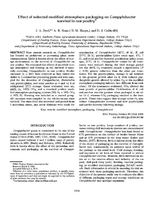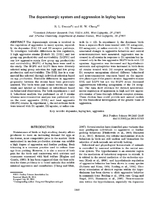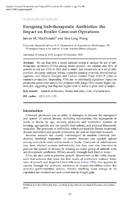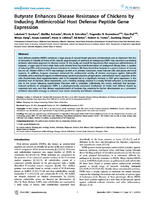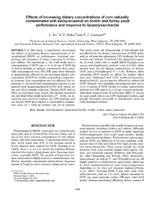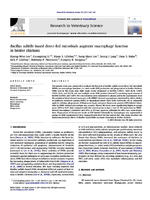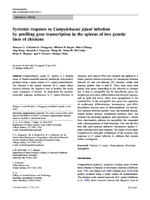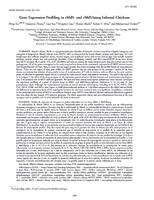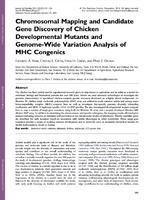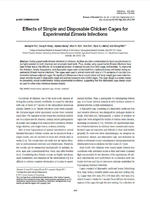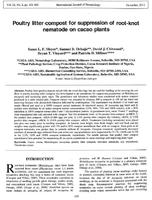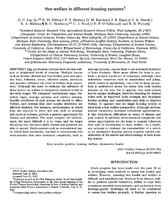Browse Items: 15
Poultry 2010: Urban Chicken Ownership in Los Angeles County, California 2010
Raising chickens in urban environments is a growing phenomenon in the United States. Urban chicken flocks are not part of the commercial poultry industry; however, they sometimes provide chicken meat and eggs to local food systems such as farmers’ markets. Urban chickens represent an avian population for which very little information is available.…
Effect of selected modified atmosphere packaging on Campylobacter survival in raw poultry
Most current research on Campylobacter has focused on preharvest or processing plant cross-contamination. Little is known about the effect of storage environment on the survival of Campylobacter on raw poultry. We evaluated the effects of modified storage atmosphere and freezing on the survival of naturally occurring Campylobacter on raw poultry.…
Tags: the poultry marketplace
Effects of Polyphosphate Additives on the pH of Processed Chicken Exudates and the Survival of Campylobacter
Campylobacter spp. are nutritionally fastidious organisms that are sensitive to normal atmospheric oxygen levels and lack homologues of common cold shock genes. At first glance these bacteria seem ill equipped to persist within food processing and storage conditions; however, they survive in numbers sufficient to cause the largest number of…
The dopaminergic system and aggression in laying hens
The dopaminergic system is involved in the regulation of aggression in many species, especially via dopamine (DA) D1 and D2 receptor pathways. To investigate heritable differences in this regulation, 2 high aggressive strains [Dekalb XL (DXL) and low group egg productivity and survivability (LGPS)] and one low aggressive strain (low group egg…
Foregoing Sub-therapeutic Antibiotics: the Impact on Broiler Grow-out Operations
We use data from a recent national survey to analyze the use of sub-therapeutic antibiotics (STAs) among broiler growers. We estimate that 42% of growers do not use STAs in their feed or water, and instead rely on a set of other practices, including pathogen testing, expanded sanitary protocols, altered feeding regimens, and Hazard Analysis and…
Butyrate enhances disease resistance of chickens by inducing antimicrobial host defense peptide gene expression
Host defense peptides (HDPs) constitute a large group of natural broad-spectrum antimicrobials and an important first line of immunity in virtually all forms of life. Specific augmentation of synthesis of endogenous HDPs may represent a promising antibiotic-alternative approach to disease control. In this study, we tested the hypothesis that…
Effects of increasing dietary concentrations of corn naturally contaminated with deoxynivalenol on broiler and turkey poult performance and response to lipopolysaccharide
In this study, 2 experiments determined the effects of increasing dietary concentrations of deoxynivalenol (DON) on performance, intestinal morphology, and measures of innate immunity in broilers and turkeys. For experiment 1, the 3-wk study used 5 concentrations of DON (up to 18 or 10 mg of DON/kg of feed in broilers or turkeys, respectively) from…
Bacillus subtilis-based direct-fed microbials augment macrophage function in broiler chickens
The present study was conducted to evaluate the function of Bacillus subtilis-based direct-fed microbials (DFMs) on macrophage functions, i.e., nitric oxide (NO) production and phagocytosis in broiler chickens. DFMs used in this study were eight single strains designated as Bs2084, LSSAO1, 3AP4, Bs18, 15AP4, 22CP1, Bs27, and Bs278, and one multiple…
Systemic response to Campylobacter jejuni infection by profiling gene transcription in the spleens of two genetic lines of chickens
Campylobacter jejuni (C. jejuni) is a leading cause of human bacterial enteritis worldwide with poultry products being a major source of C. jejuni contamination. The chicken is the natural reservoir of C. jejuni where bacteria colonize the digestive tract of poultry, but rarely cause symptoms of disease. To understand the systemic molecular…
Gene expression profiling in rMd5- and rMd5Δmeq-infected chickens
Marek’s disease (MD) is a lymphoproliferative disorder of domestic chickens caused by a highly contagious and oncogenic α-herpesvirus, Marek’s disease virus (MDV). MD is characterized by bursal–thymic atrophy and rapid onset of T-cell lymphomas that infiltrate lymphoid tissues, visceral organs, and peripheral nerves with severe clinical signs that…
Chromosomal Mapping and Candidate Gene Discovery of Chicken Developmental Mutants and Genome-Wide Variation Analysis of MHC Congenics
The chicken has been widely used in experimental research given its importance to agriculture and its utility as a model for vertebrate biology and biomedical pursuits for over 100 years. Herein we used advanced technologies to investigate the genomic characteristics of specialized chicken congenic genetic resources developed on a highly inbred…
Analysis of global transcriptional responses of chicken following primary and secondary Eimeria acervulina infections
Characterization of host transcriptional responses during coccidia infections can provide new clues for the development of alternative disease control strategies against these complex protozoan pathogens. Methods: In the current study, we compared chicken duodenal transcriptome profiles following primary and secondary infections with Eimeria…
Effects of Simple and Disposable Chicken Cages for Experimental Eimeria Infections
During experimental Eimeria infections in chickens, facilities are often contaminated by fecal oocysts known to be highly resistant to both chemical and enzymatic treatments. Thus, studies using experimental Eimeria infections have been limited due to the difficulty of complete elimination of residual oocysts from both cages and facilities. To…
Poultry litter compost for suppression of root-knot nematode on cacao plants
Poultry litter (poultry manure mixed with the wood shavings that are used for bedding or for covering the soil floor in poultry housing units) compost was investigated as an amendment for suppressing populations of Meloidogyne incognita and increasing plant vigor. The greenhouse and laboratory studies were conducted with mature compost produced in…
Hen welfare in different housing systems
Egg production systems have become subject to heightened levels of scrutiny. Multiple factors such as disease, skeletal and foot health, pest and parasite load, behavior, stress, affective states, nutrition, and genetics influence the level of welfare hens experience. Although the need to evaluate the influence of these factors on welfare is…
 An official website of the United States government.
An official website of the United States government.



